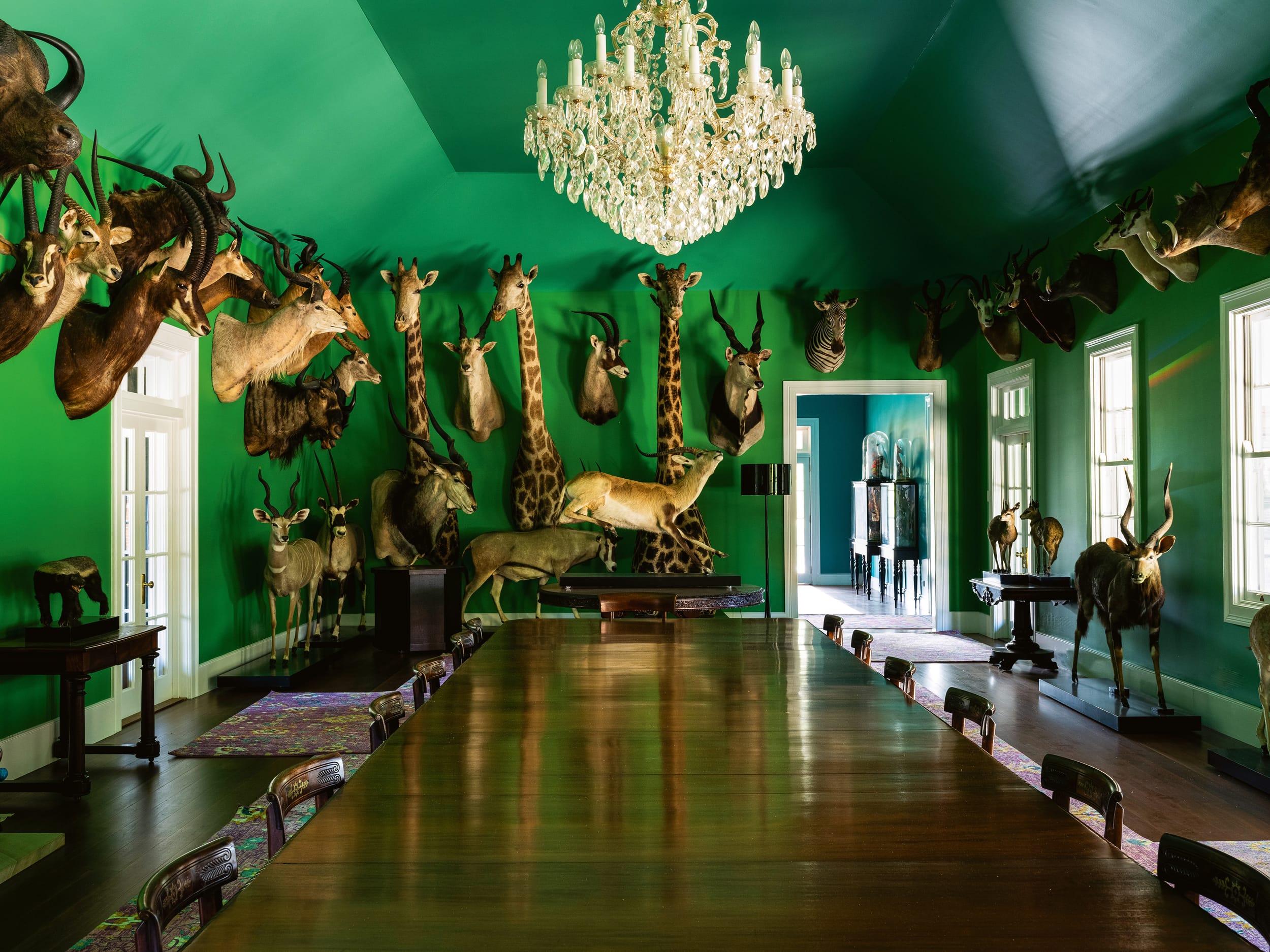
From his private museum and botanical garden in the Hunter Valley, Dale Frank, one of Australia’s most commercially successful artists, is pouring resin and planning his legacy.
Words Luke Slattery
Photography Brigid Arnott
A HORNED yak, quite dead but in other respects the picture of health, greets the visitor to Dale Frank’s studio, home, private museum and botanical garden on a 50-acre property near Singleton. The yak, a fine example of the taxidermist’s art, stands in a niche at the entrance to a long gallery with glowing green walls.
Next in line is a framed tiger head and skin splayed out behind glass. “Extinct now,” proclaims the artist in a stagey tone, “but when the Dutch colonised Java they heard reports of village children taken by the Javanese tiger.” Directly beneath it, on a narrow serving table topped with scarlet-coloured porphyry marble, stands a stuffed aardvark with rabbity ears and chunky hooves. “If you pat him nicely, he’ll lick you with his 30-centimetre-long tongue,” says Frank. Quick with arcane facts, the 64-year-old artist seems to be enjoying the role of knowledgeable, occasionally cantankerous guide to his zoological necropolis.
On the next table, of Anglo-Indian colonial provenance, stands a startled ring-tailed lemur and a ruffed lemur either side of a Jurassic-sized egg with a zigzag of craquelure. “An elephant bird egg,” declares Frank. “I’m told there are only 16 intact specimens in the world. Elephant birds became extinct about 150 years before the dodo. They had one egg every five years; to have an egg was extremely rare. It was double the size of dodos and emus, couldn’t fly, and lived in Madagascar.”
It’s a dizzying ensemble – a many-roomed wunderkammer, an antipodean cabinet of curiosities, ornamented with refined antique colonial furniture. The serving tables are dwarfed by a 24-place banquet table of carved mahogany beneath a florid chandelier, surrounded by wall-mounted zebras, oryx, wildebeest, hartebeest, gemsbok, impalas, antelopes, elands, kudus, nyalas and a couple of giant forest hogs. At the far end of the dining room stands a “ta‑dah” trio of giraffes reaching almost to the vaulted marine-green ceiling. To say that these zoological trophies are conversation pieces understates the point – it’s hard to imagine a conversation at this magnificent table about anything else.
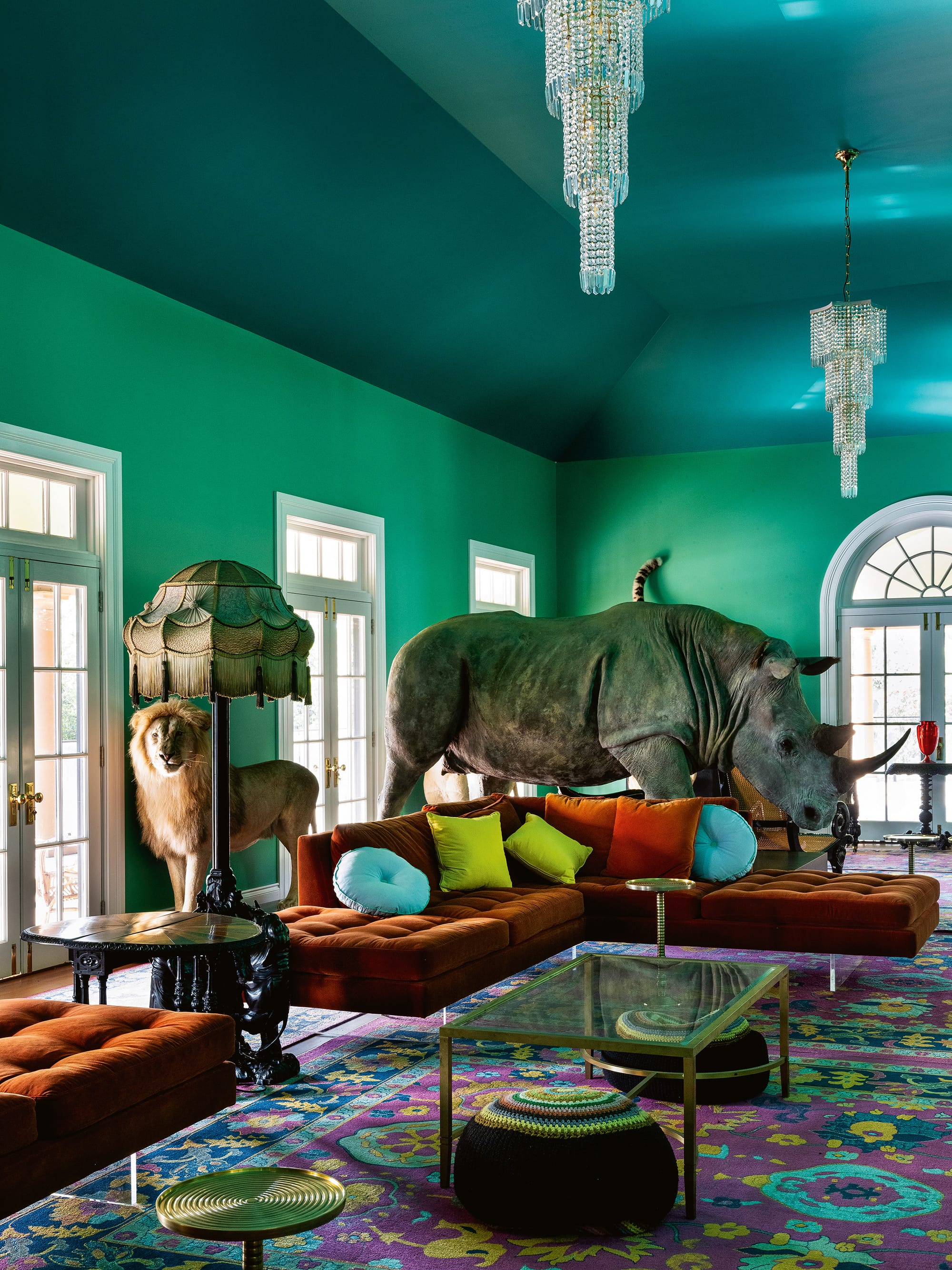
We pass from the dining room to the artist’s office – home to a couple of mountainous polar bears – which is connected to another wing fronted by a deep colonnaded verandah. The most impressive specimens in this wing are two rhinoceroses, a pair of tigers, a magnificent snow leopard, a cheetah, a baboon and a trio of grinning hyenas. Were any of these creatures hunted for this collection? He eyes me severely. They’re from historical repositories and museums, he insists, and for the most part the animals “died from natural causes in wild parks”. An exception is Betsy, a deceased rhino from Dubbo zoo.
The elephant in the room, however, was too big to fit through the doors, and the wing has since been filled with other ex-animals. The elephant resides in a freezer in Melbourne while another vast space is being constructed in Frank’s house. The challenges are elephantine. The creature is yet to be reconstituted from a skin into a simulacrum of its former self. “It takes up to six men to build the internal steel structure, then to mould the form, one of them a specialist in carving the muscle structure, then mounting the skin over this form, and install and secure his tusks.” By then, Frank concedes, “it’s too tall for any freight vehicle” and even when the transport problem is solved it will need to be craned into place before the new wing can be completed around it.
After a morning’s work in the studio Frank guides me around his fantastic collection, which includes a vast insect collection surplus to requirements and shoved into a blind corner. It’s here that he works on up to four “poured” paintings at a time. His trousers are streaked with vividly coloured resin, as are the floors. His most recent paintings are swirling translucent polyurethane resin and epoxyglass on perspex – intensely coloured and highly textured.
Most mornings, he tells me, there’s time before work for a stroll around his vast garden of more than 7500 trees and plants, many of them cacti and other drought-tolerant species. If the weather is good he’ll take a plunge in his walled 10-metre pool and it’s left him with a healthy tan. He is balding and whiskered, with a luxuriant moustache.

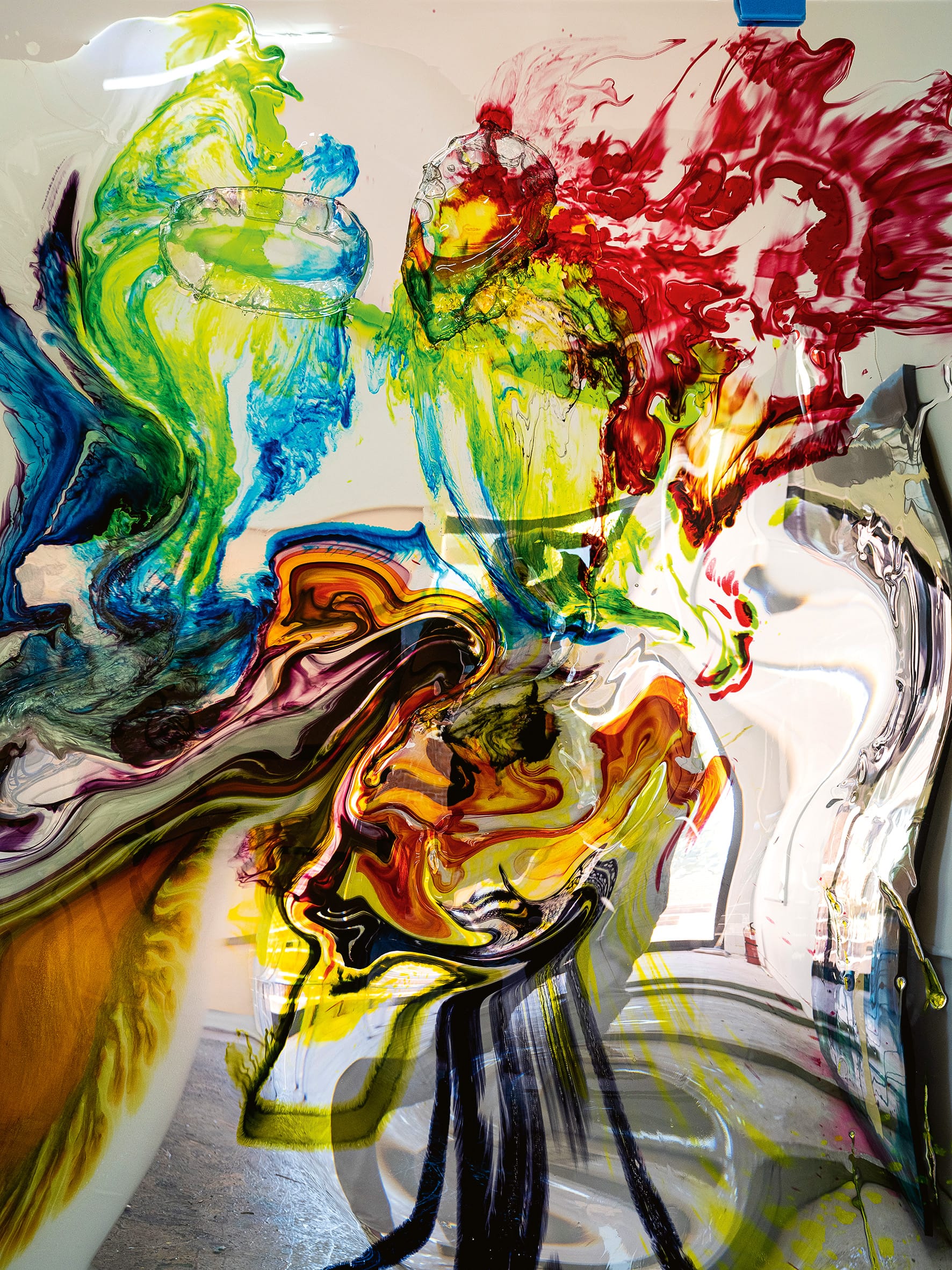
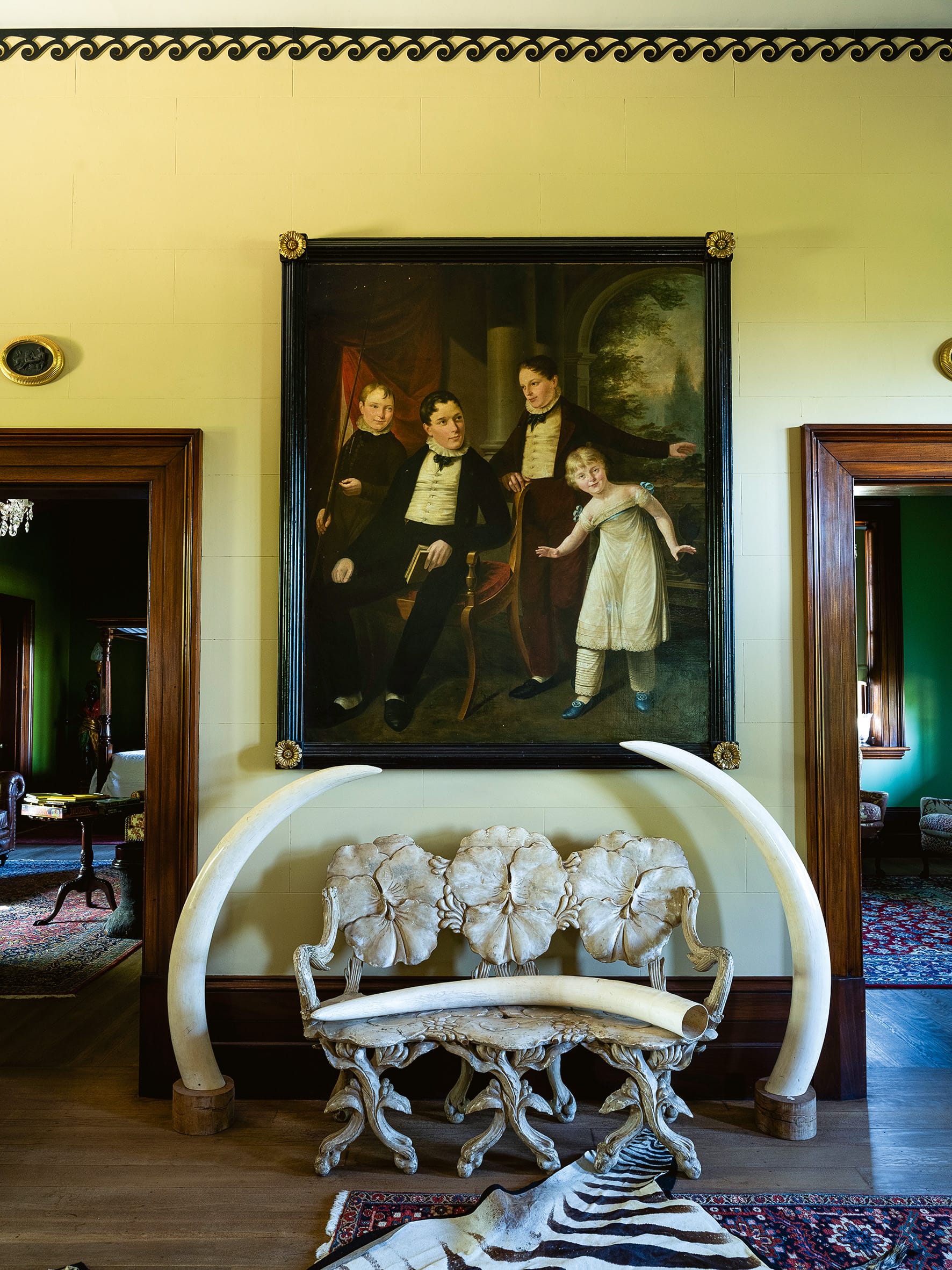

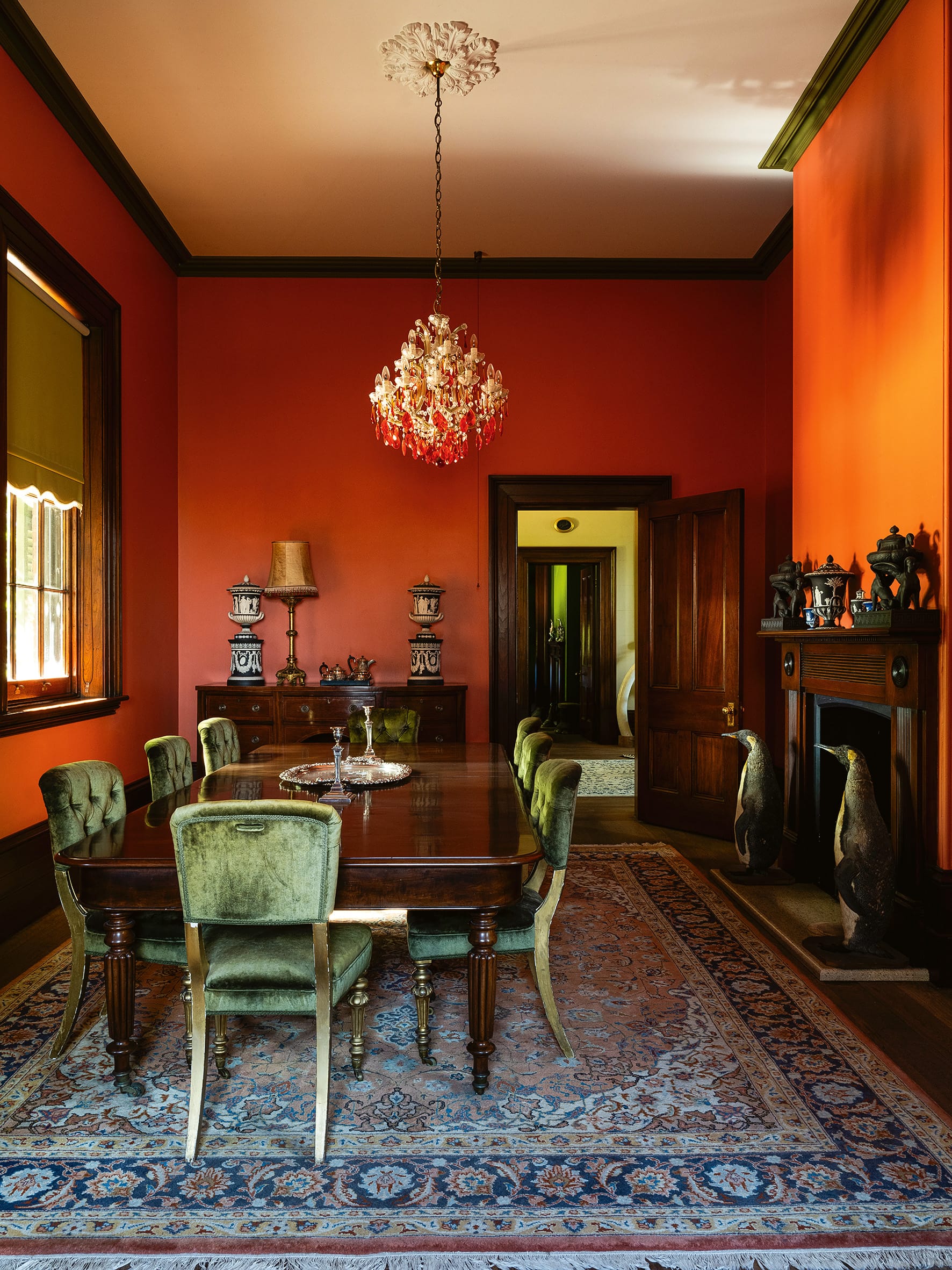
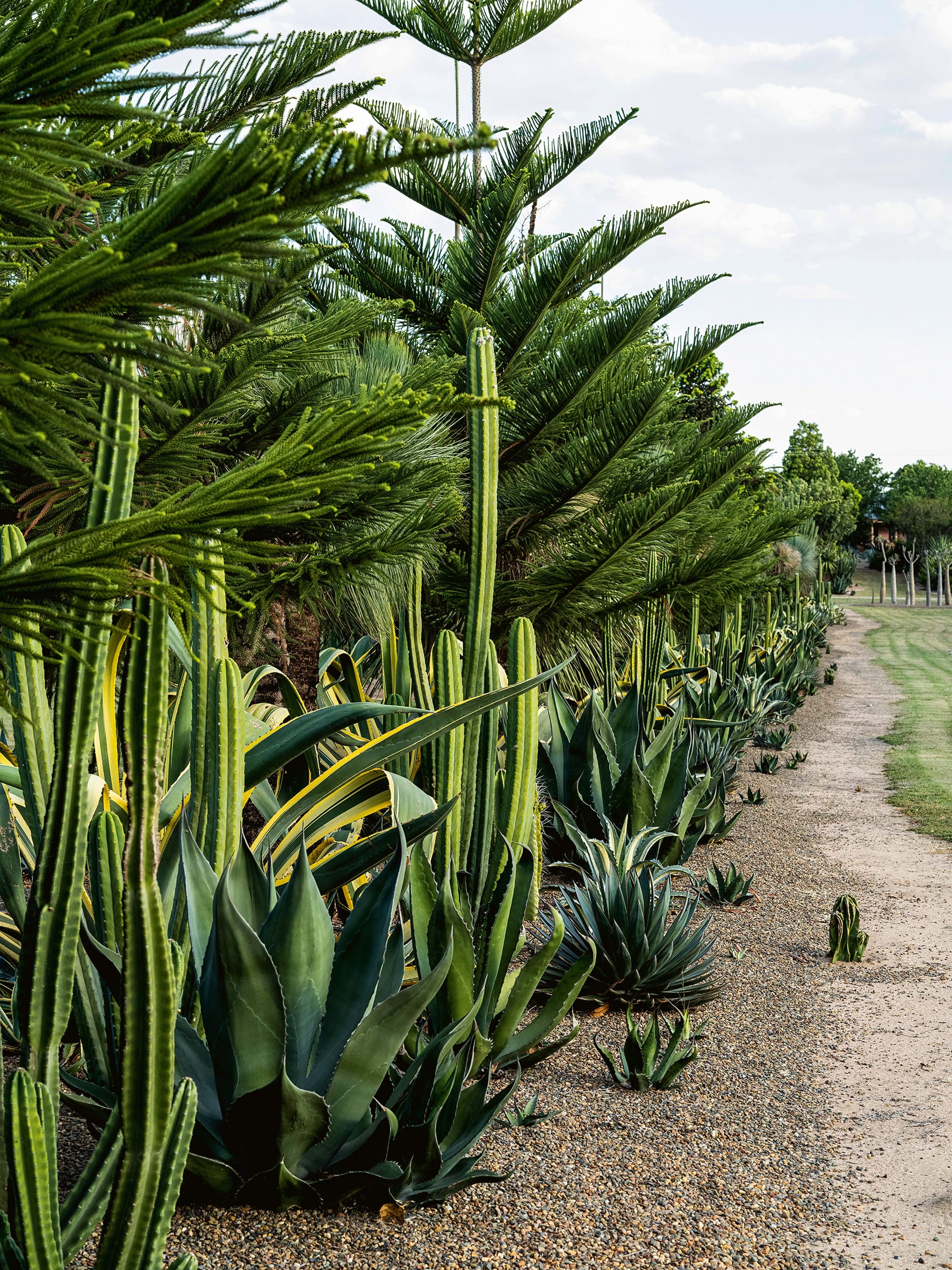
Hambledon Hill House; artist’s unnamed work; Regency portrait above an Italian Renaissance settee and elephant tusks; pines and succulents; a Javanese tiger skin hangs over an aardvark, lemurs and an elephant bird egg; breakfast room with penguins; a glimpse of a long garden bed studded with Agave americanas. Photography by Brigid Arnott.
The artist’s house stands on the grandly named Hambledon Hill, all of 57 metres above sea level, on a bend in the Hunter River. The son of a farm worker, he was raised in the district and educated at a one-room primary school with 18 students. “My brothers and sisters and cousins and other farm people made up the school. The mothers would come in and make hot tomato soup for lunch in the winter and hamburgers in summer. I tell people that to get to school and back each day it was a six-hour walk, and they think it’s an exaggeration, but it’s not – sometimes, though, you’d be lucky enough get a lift in the morning from the milk truck.”
There’s a fond tone to his childhood recollections. “We all, and I’m not alone, think of the good old days – not the fact that I had to suffer for 20 years with ingrown toenails because of walking so far in tight shoes.” Snakes feature strongly in his childhood story. On hot summer nights the children would sleep on a verandah, and the sight of a black snake sipping milk from the cat’s bowl is seared in Frank’s memory.
The transition from a tiny primary school to a regional high school of 750 was, he recalls, difficult. “I didn’t thrive. I thought it was my fault.” He was a precocious teenager. “All through secondary school I was working as an artist and having exhibitions and entering art prizes from the age of, like, 15. I was in the Wynne Prize at AGNSW from the age of 16. There used to be a lot more regional art prizes in the ’70s, with quite highly regarded judges on the panels, and I would research the judges’ works and embrace them while offering my own take on it, and that’s how I won so many art prizes. The judges saw themselves in my work, but they also saw me.”
“Genius,” I remark.
“Not genius,” he shoots back. “Autism.”
Frank lasted three months at the Sydney College of the Arts. “It was ridiculous. We were told to create a sculpture that depicts growth, and everyone is working with plaster and doing representations with things, and I just went out into the yard and turned the tap on and said, ‘This is my sculpture’.”
With that audacious gesture the kid from Singleton announced to the Sydney art world that he would chart his own course. In 1981, in Milan, he exhibited a sculpture of the clothed lower half of his body protruding from the ceiling, and for his 1995 show I’m Only Dancing, he built a complete disco with an automated lighting system, dry-ice machines, a mirror ball, and a viscerally deep bass beat designed, he says, to “produce a casual physical sensation in the body”.
The school that formed and polished his artistic personality, though, was a life spent in art, among other artists. “With my unemployment benefits I saved up enough for a one-way trip to Europe.” The year was 1979, and he would spend the better part of the next decade living and working in Europe – mainly Milan and Amsterdam – and New York, “talking to artists about art and seeing great art”.
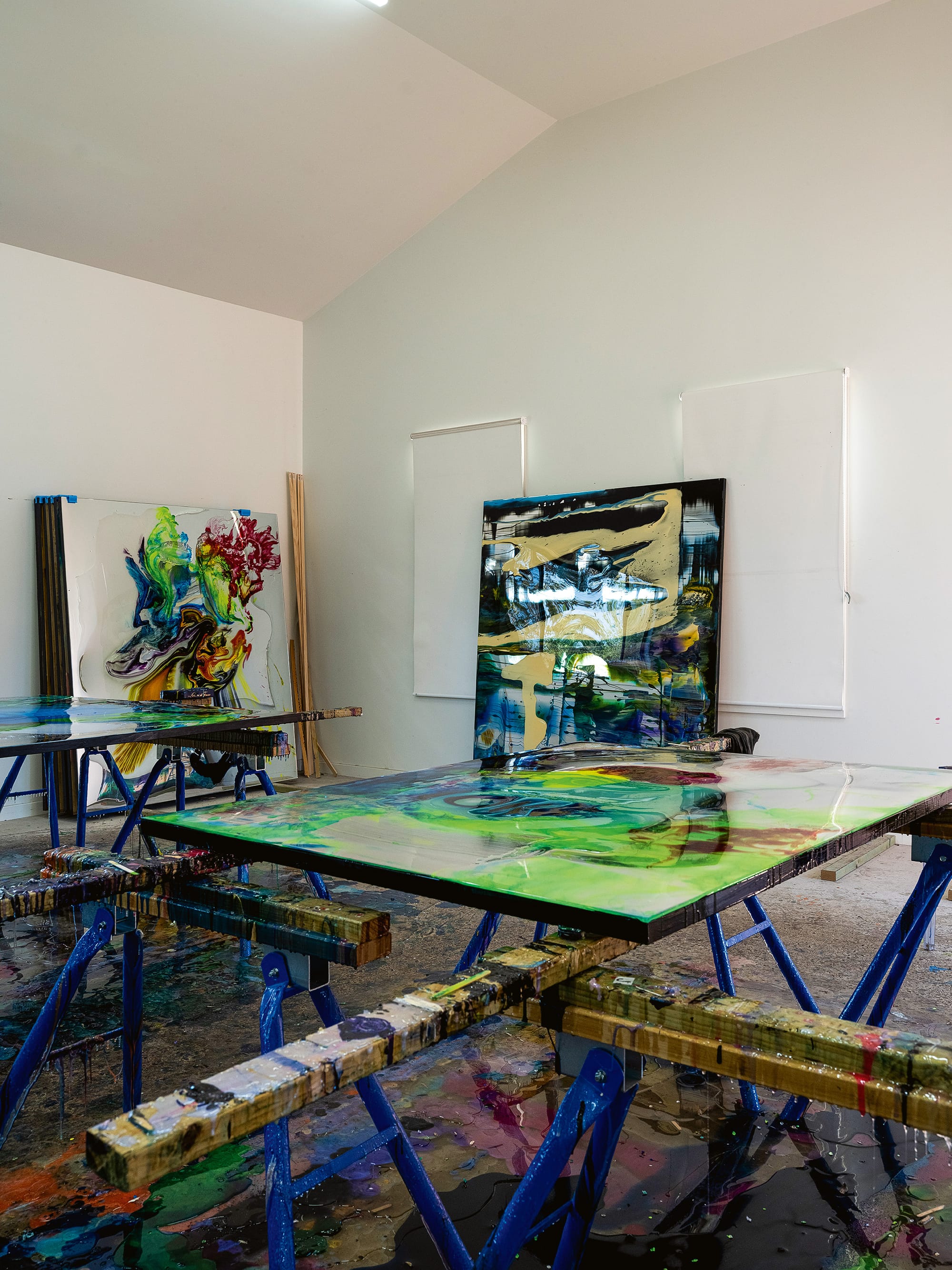
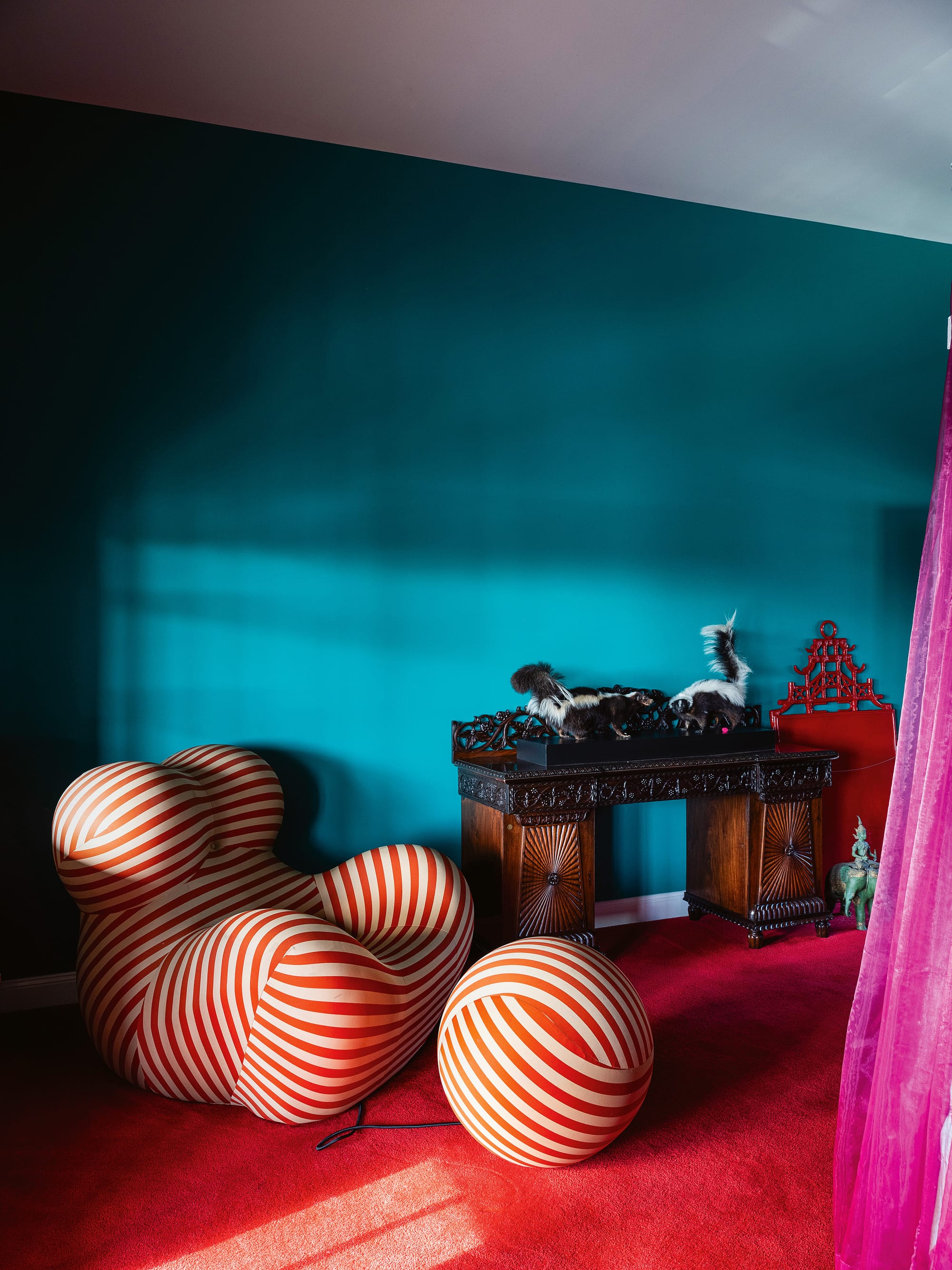
Artist’s studio at Hambledon Hill House; in a bedroom, Big Mama Up armchair, designed by Gaetano Pesce, beside an 1820 Anglo Indian sideboard topped with two American skunks. Photography Brigid Arnott.
Ron Radford, a former director of the National Gallery of Australia, has watched with often astonished admiration as Frank evolved from sometime performance artist to a formal innovator and daring colourist, and one of Australia’s most commercially successful artists. “He became very interested in montage, and now he’s working on these amazing, very sensuous, quite thrilling enamel pictures,” says Radford. “It’s very hard to breathe new life into abstract art, but he’s certainly done that.” For Radford, who took the pulse and the temperature of contemporary art during a curatorial career spanning more than four decades, Frank is the distinctive sum of many rarely combined parts: an innovator in the plastic arts, a collector, and a connoisseur of colonial art and furniture. “They certainly broke the mould when they made Dale Frank,” he remarks.
He’s been shown at the Venice Biennale and his work is held in institutions the likes of the Museum of Fine Arts in Boston, the Solomon R Guggenheim Museum in New York and the Kunsthaus, Zurich, as well as every major public collection in Australia.
Since 1982 the artist’s work has been represented by Roslyn Oxley9 Gallery in Sydney. It’s been a 41-year relationship, he says, in which we’ve “been, working together, getting to know each other intensely and intuitively”.
After his permanent return to Australia, Frank gravitated to what he calls “regional situations”. He settled in the Lockyer Valley west of Brisbane, then in the Hunter Valley town of Scone. He bought the Hambledon property in 2012 after he was “gazumped” on an offer for a Georgian pile in Tasmania. The next five years were spent repairing and rebuilding the 1860s mansion and redecorating in his exacting, exuberant style: a bedroom has been given a full Bollywood treatment; the bathroom beside it clad in pale green glass bubble tiles left over from the Beijing Olympics aquatic centre. “The house is a labour of love?” I ask. “A labour of grafting,” he replies crisply. “And borrowing, stealing, against eventual mortality.”
He runs through a list of insults the building has endured in 150 years: concreted floors, orange tiles, chipboard architraves painted mission brown, glassed-in verandahs. When he first laid eyes on the grounds they were a mess of dying gums. More than a few trees, however, have survived from the original mid 19th-century plantings: two hoop pines and a kauri pine, a Moreton Bay fig, a few silky oaks, a South African kaffir plum, and a carob. Frank’s own botanical contribution, numbering in the thousands, is skewed towards sculptural succulents, some of them seven metres tall, laid out either side of an avenue. His dry garden – unirrigated, relying on natural rainfall and semi-arid and arid species – is a deliberate response to the changing climate and this, he says, is rare. “Some of my favourite similar gardens are historical – Huntington, Lotusland and Bancroft Garden in the US – and the gardens designed today by Spanish landscape designer Fernando Caruncho that owe as much to art and science as they do to horticulture.”
The historical core of Hambledon Hill is red brick on a sandstone base, with cast-iron balustrades, towering ceilings, French doors, and a colonial plantation air. The main entrance, rarely used now, looks south-west onto the Hunter River, an expanse of irrigated land, and the hills beyond. The view in this direction is framed by a set of stone sphinxes. The classicising motif extends inside with several Wedgwood collections, Georgian portraits, and a late Renaissance settee. There’s also a splay of elephant tusks. “All 150 years old!” he roars. “I had nothing to do with shooting them!” Two more zoological trophies – penguins reputedly from Scott’s Antarctic expedition of 1910-13 – flank the fireplace in a room painted Vesuvian red.
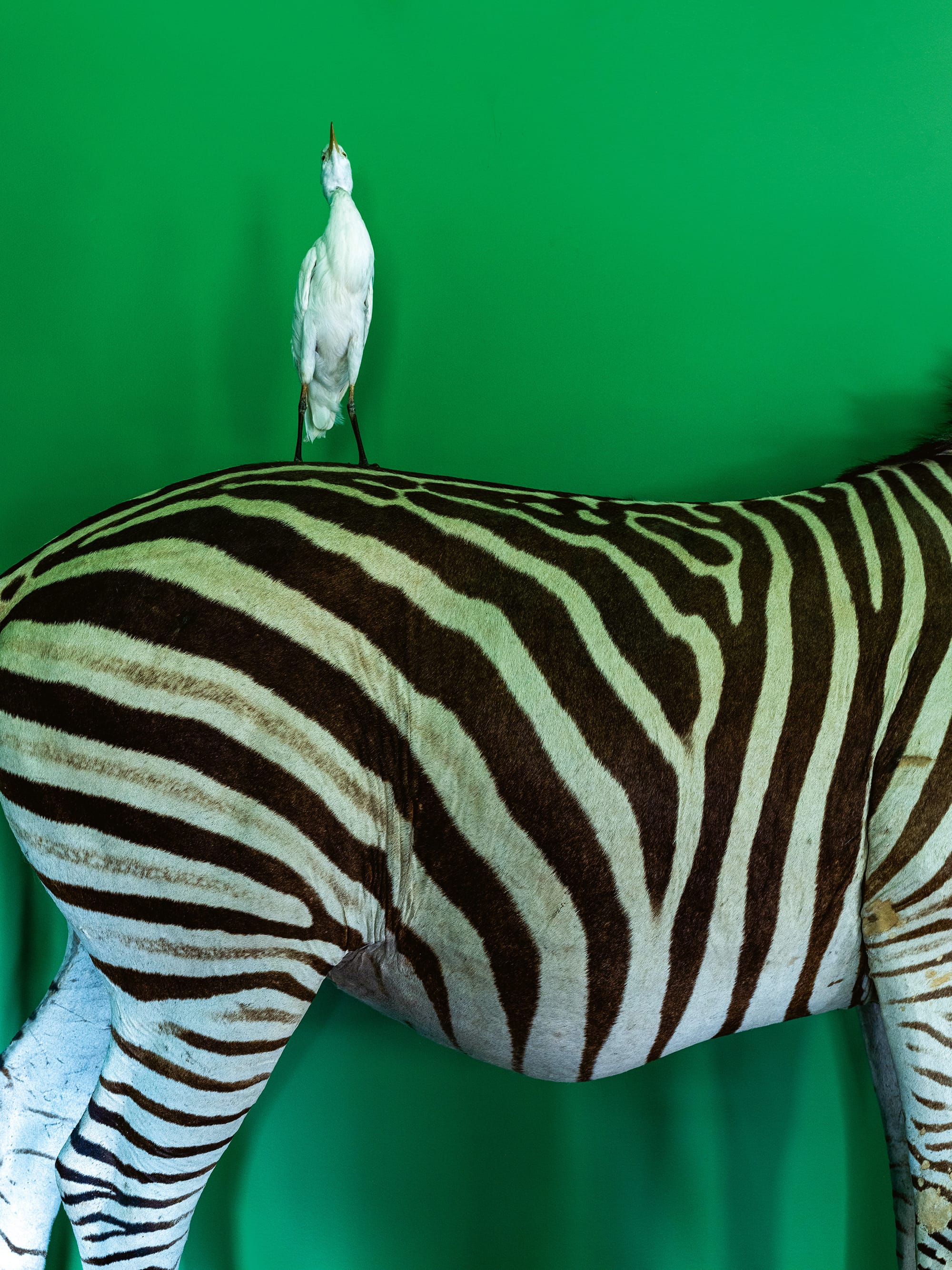
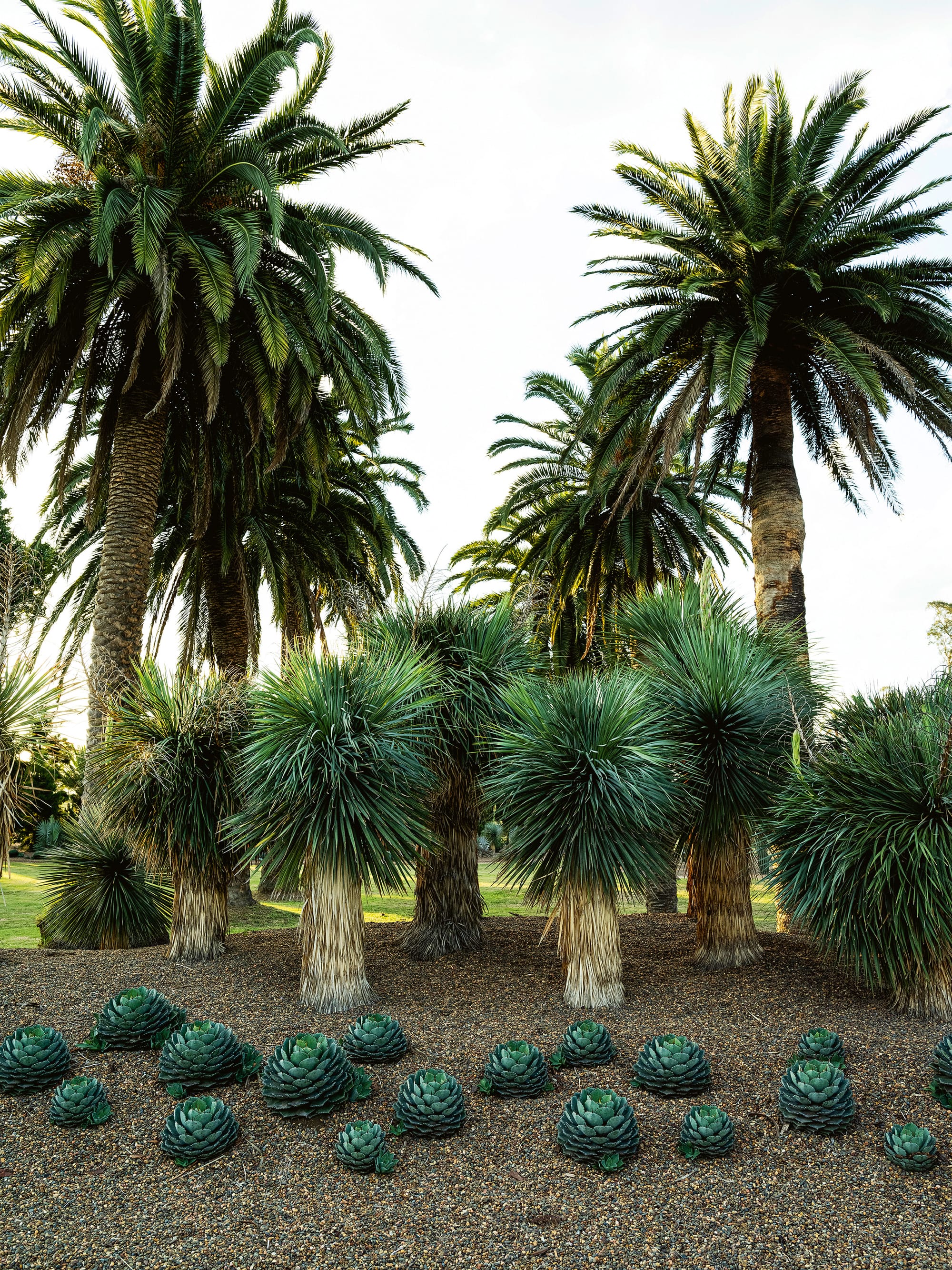

Yucca rostrata surrounded by baby Agave potatorum along one of the avenues of Canary Island palms. In the original 1860s wing, an Anglo-Indian four-poster bed stands in a bedroom furnished with antiques. Photography Brigid Arnott.
Frank has had undiagnosed autism for most of his adult life. Wearied perhaps by the psychological effort of trying to fit in, he has fashioned a world to dovetail with his curiosities and passions.
He’s at once a conceptual artist with a performative streak whose career has been spent challenging conventions and a nerd collector with a deep love of tradition and an archivist’s attention to detail. Draped over a chair in the kitchen on this 35-degree day is a russet-coloured tweed coat. “I like traditional tartan tweed suits,” he says. Frank likes things in multiples; he possesses three full-dress tweed ensembles. “I remember as a child my Scottish grandfather saying you could aways tell a gentleman – he smelt like horse piss when it rained. Traditional tweed suits used to be soaked in vats of horse urine to make the colours stay fast, but unfortunately when they were caught in the rain, the fabric smelt of horse piss.”
Frank gives long episodic titles to his swirling epoxyglass works. The title of a recent work reads like the synopsis of a surreal soft-porn sitcom: There was a clearly noticeable problem after Ryan’s third significant Penis Enlargement operation as each of the three Medical Centres had all unknowingly taken fat tissue from the same butt cheek leaving him massively bulbous from the front and lopsided from behind forcing him to end his dreams of becoming an exotic dancer on tik tok. The art always comes first, Frank says. It’s only after peering into the abstractions he has let loose on the world – exploding nebulae, molecular eruptions, atmospheric apparitions – that the words begin to flow “for the novel I’m writing, the diary, about people and situations, the ether of what’s happening in the world”.
As the sun fades, the hot westerly wind stiffens ahead of a cool change. It’s time for Frank to take a tootle around his botanical park in the golf buggy. The driveway from the main gates to the garden is lined densely with Agave americana; another avenue is lined with jacarandas and native cadaghi trees (Corymbia torelliana). We sweep past hundreds of trees, many of them rare and exotic, evoking scenes from the southern Mediterranean, Madagascar or Middle Eastern deserts, like tales from The Arabian Nights in horticultural form.
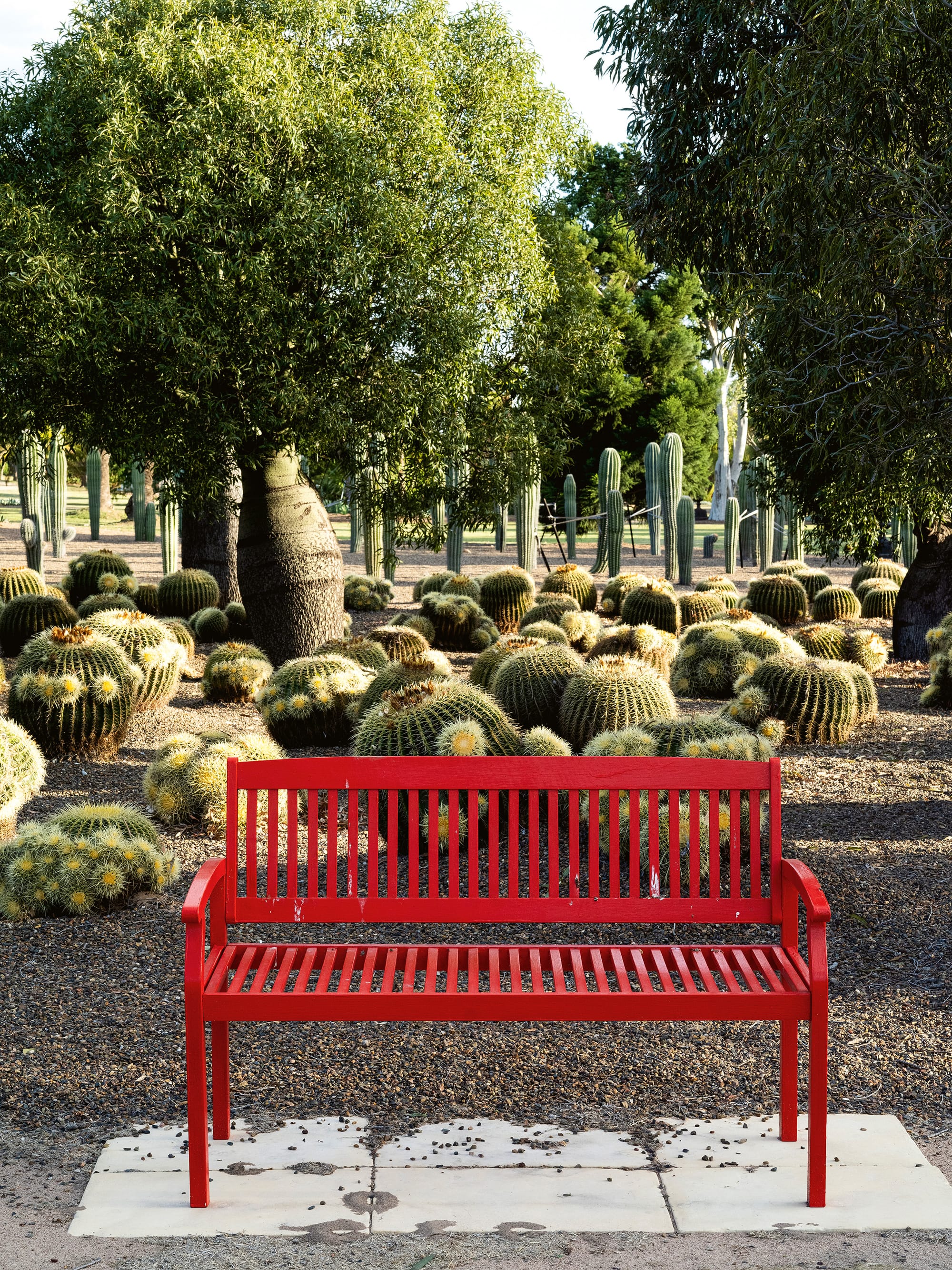
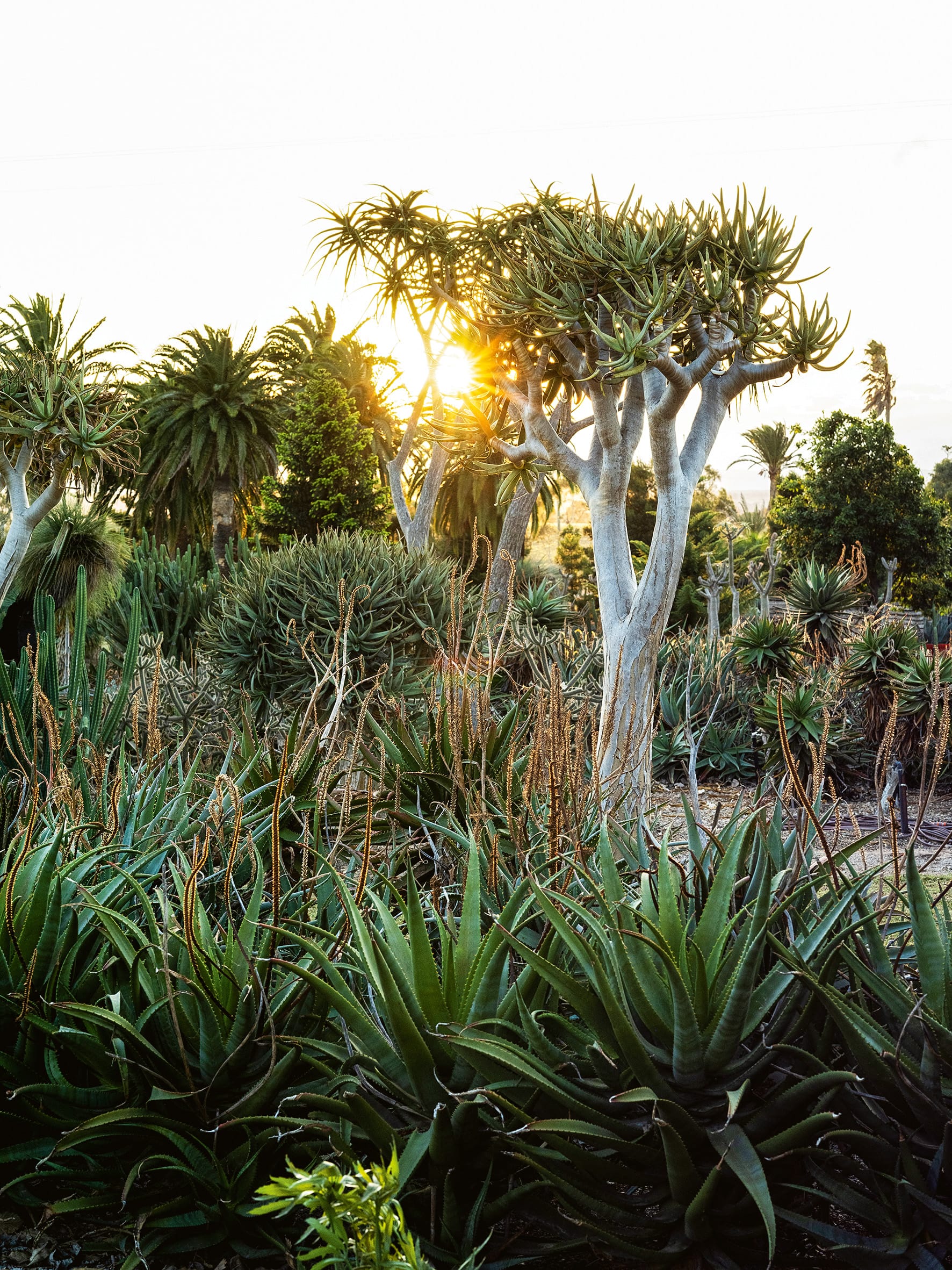
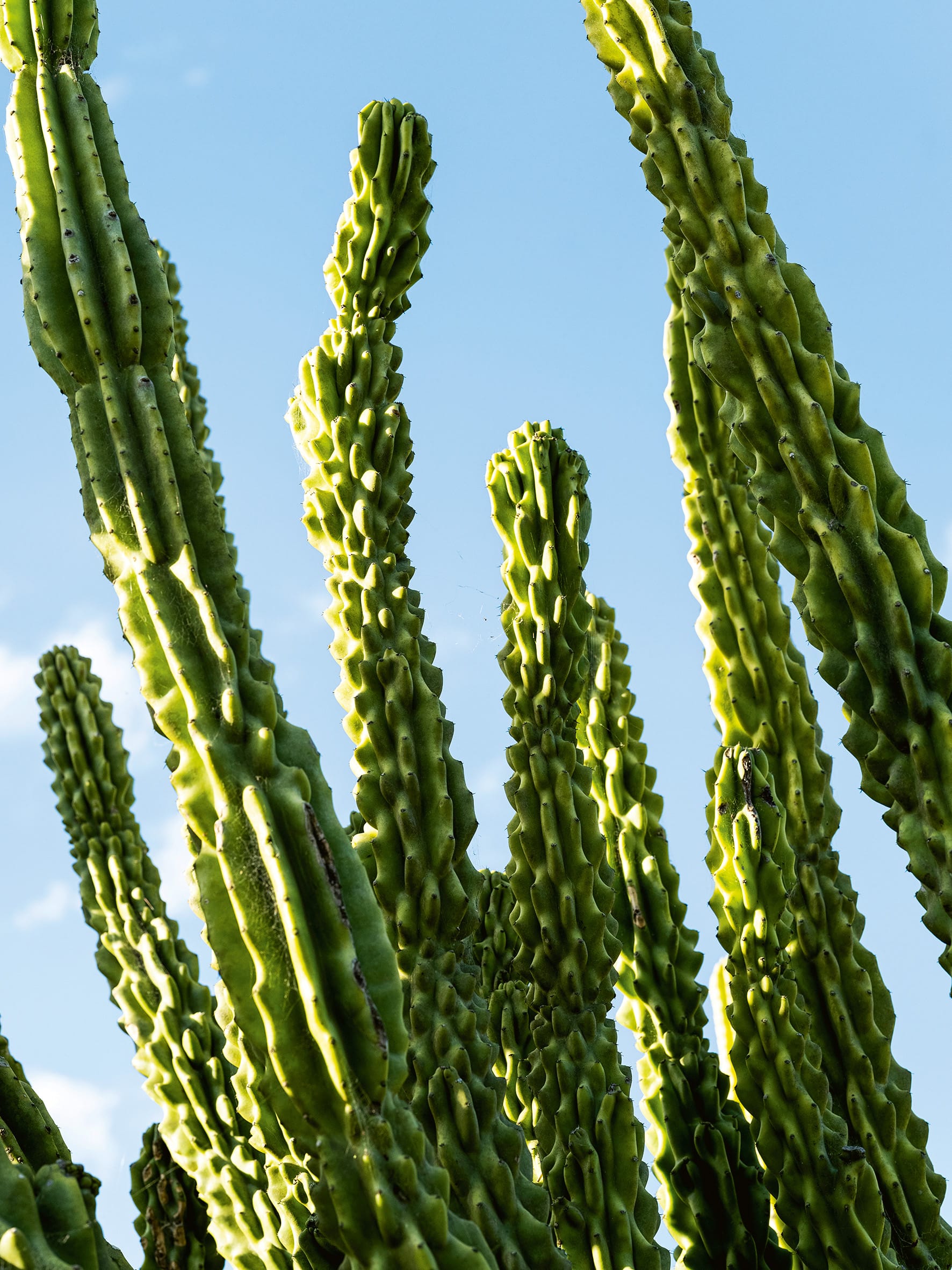
Among more than 7500 plants are (top image, or left if you are reading this on a computer screen) these Golden Barrel cacti under Queensland bottle trees. Drought-tolerant plants include (middle image) a rare quiver tree (Aloe dichotoma) and one of many Cereus monstrose cacti. Photography Brigid Arnott.
Later, with help from Frank’s carefully documented plant inventory, I identify a dense grove of Chinese elms (about 160), dragon trees (two dozen), Roman pines (16), rare and endangered quiver trees (six), mature tree aloes (65), Cussonia (eight), two rare African cabbage trees, nine Algerian oaks, the latter with “the widest spread of any tree in the world”. There are also 82 European fan palms, 32 bunya pines, 68 hoop pines, 25 Norfolk Island pines, 36 bottle trees, an alley of 36 olives trees, 28 Canary Island palms, 30 mature African date palms, and 36 Washingtonia palms. “When I first saw it, this was just a brown paddock,” he says proudly with an expansive gesture. “The land had been through four years of drought. We’ve since had eight years of drought and two of rain. The first year of rain the annual was greater than the previous four years combined.”
Many of his plantings are mature trees that arrived on trucks before dawn for transplantation in the site’s sandy soil; some are donated – rescue trees. And yet the garden, in Frank’s mischievous hands, is more than a botanical ark. It’s another excuse for a game. “I’ve arranged it all around alleyways and sights,” he explains. “But halfway down an avenue you’ll find an alternative path, and you won’t really know which way to walk. It’s designed so that you never actually see the whole thing in one go.”
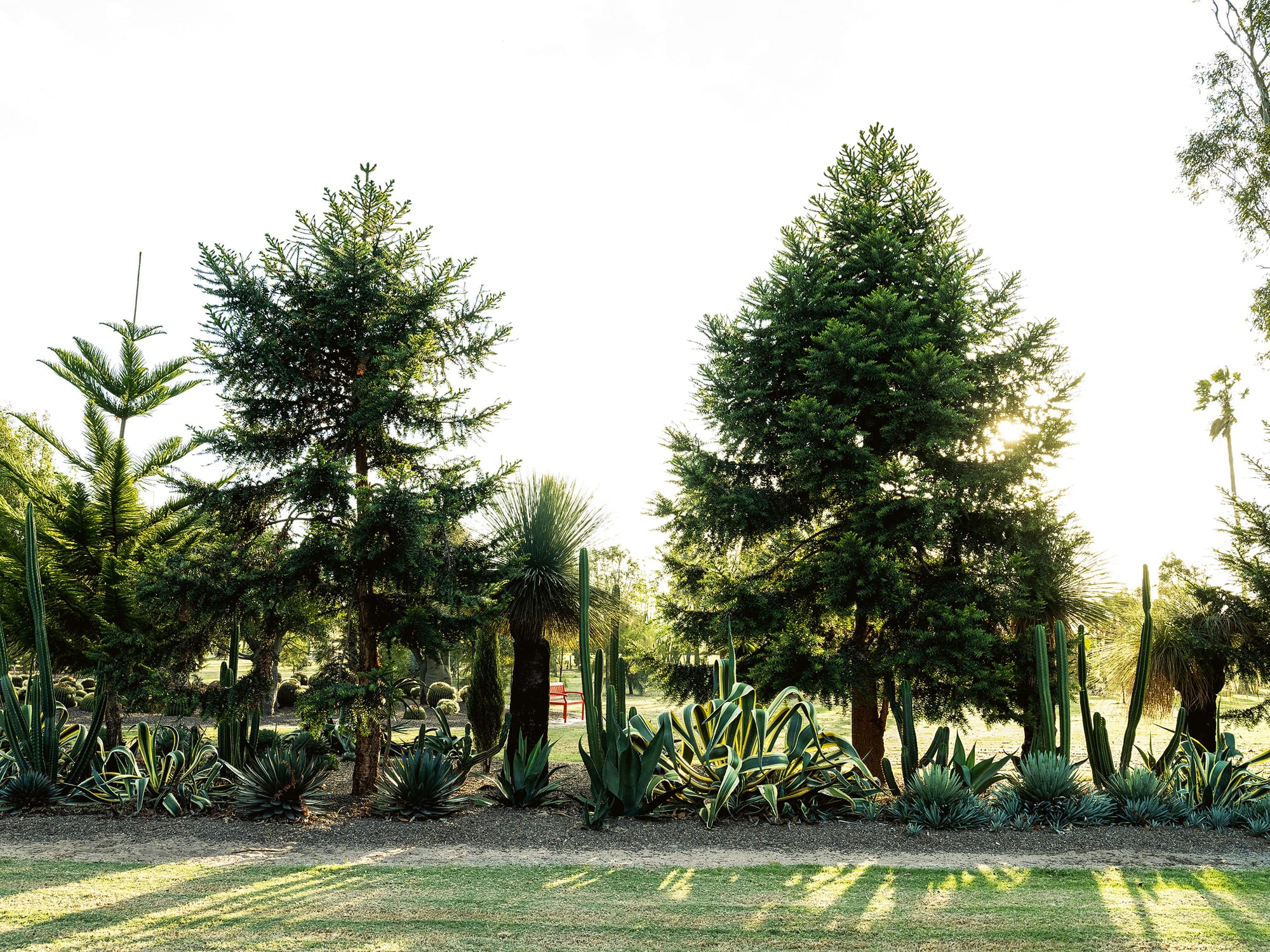
When we return to the big house he excuses himself, and pecks at a keyboard. A little later, I hear gentle snoring and catch a glimpse of the artist asleep on a couch in his study, in view of the polar bears.
The taxi driver who delivered me to Frank’s doorstep spoke of his legendary parties, but when I mention this to the artist, he’s aghast. “I’ve never had a party here,” he insists. “They [the town’s residents] imagine all sorts of things. There are so many stories and none of them are true.” Though built for many, the house is enjoyed, for the moment, by few. During our chat he’d complained of “too many people and too many questions”, and before it had even begun he insisted that he not be photographed.
In time, he says, all that will remain is the big house and the garden and his own art, and one fewer tweed suit – he intends to be buried in one. “I’m conscious of my legacy every day,” he says. Almost a decade ago he donated 85 works valued at $4 million to the National Gallery of Australia. “I have long held the belief that at an appropriate time in an artist’s career, in an artist’s life, the gifting of a body of the artist’s work to the public is incumbent, is vital for sustaining cultural life,” he said at the time. He plans now to donate his work to an estate that can “deal with it in the future as understanding of art changes”.
He works every day. The constant rhythm of his artistic practice, he believes, sets him apart from many Australian artists who teach for a living, focusing their art practice on upcoming exhibitions. “What I took from everyone I spoke to as a young artist in Europe agreed with my own sentiments exactly. They all pressed the idea that the only way for your own work to evolve and to develop was to discover new territories, new ways of seeing. And this meant working consistently. Only through constantly pushing yourself and your work in the studio can you ever place it in undiscovered worlds; worlds that you yet cannot imagine. You die with thousands of unexhibited works – as one or two have done. Your work’s future is well beyond your studio span.”
He is planning for residencies at Hambledon Hill – one for artists and the other for gardeners. Included in his legacy planning is an exhibition space for contemporary art. “I don’t care what people say about my own work. I want them to make fun of my work. But it’s very important that they see the most contemporary art. Because that was never around when I was a young artist.” Will the art he leaves for posterity change the way he’s seen? “Hopefully yes,” he answers. “That’s all I will say.”

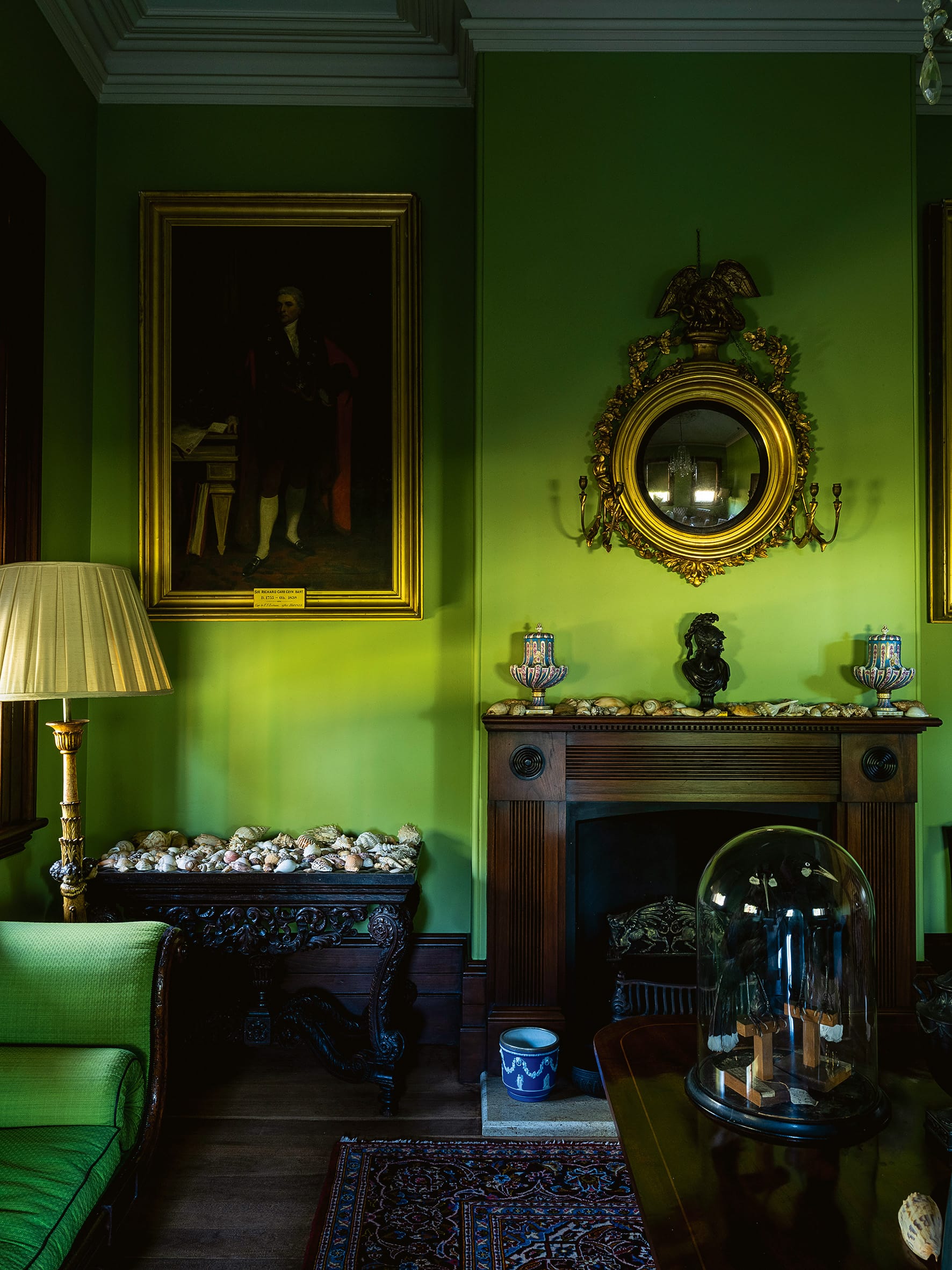
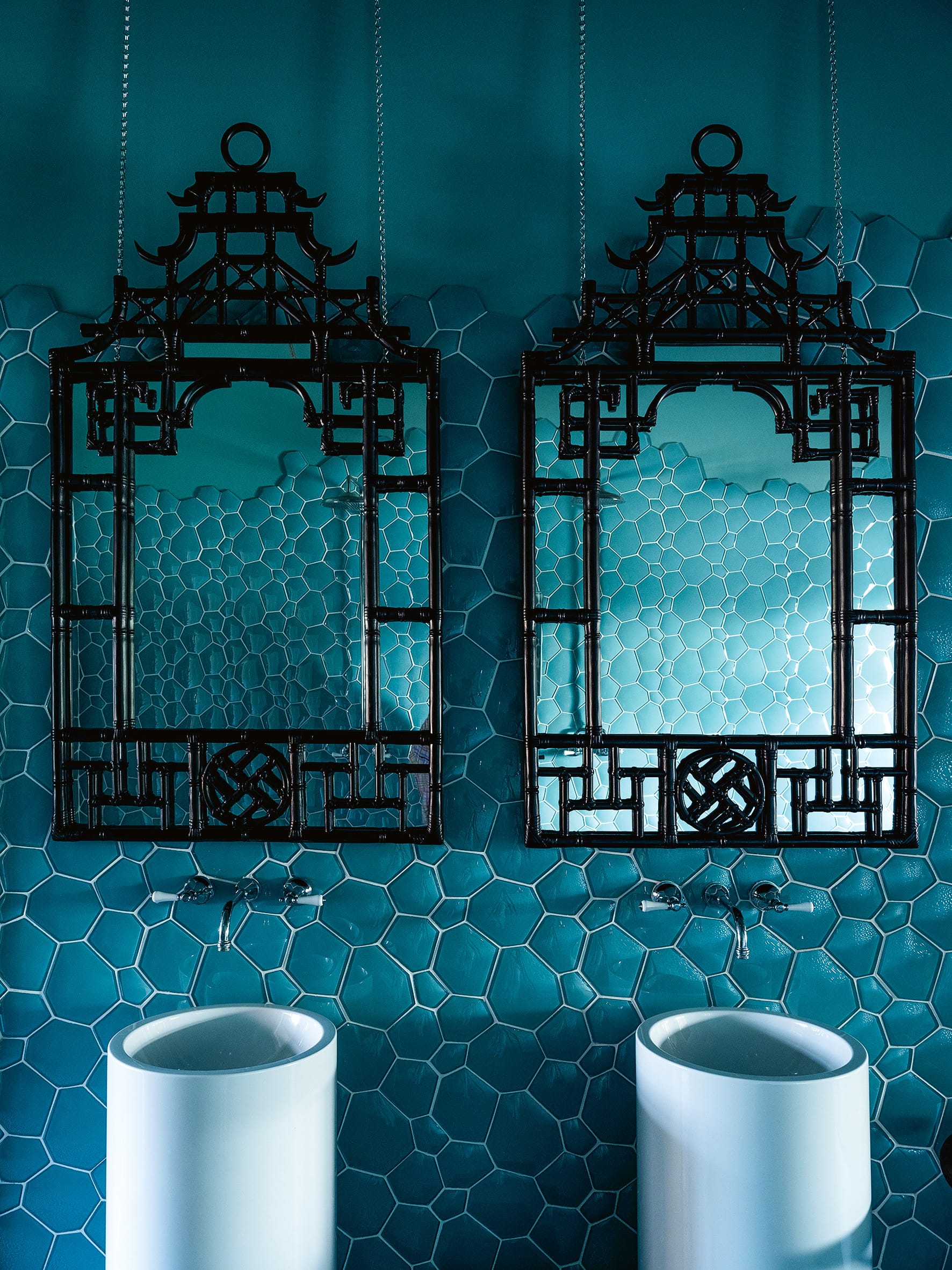
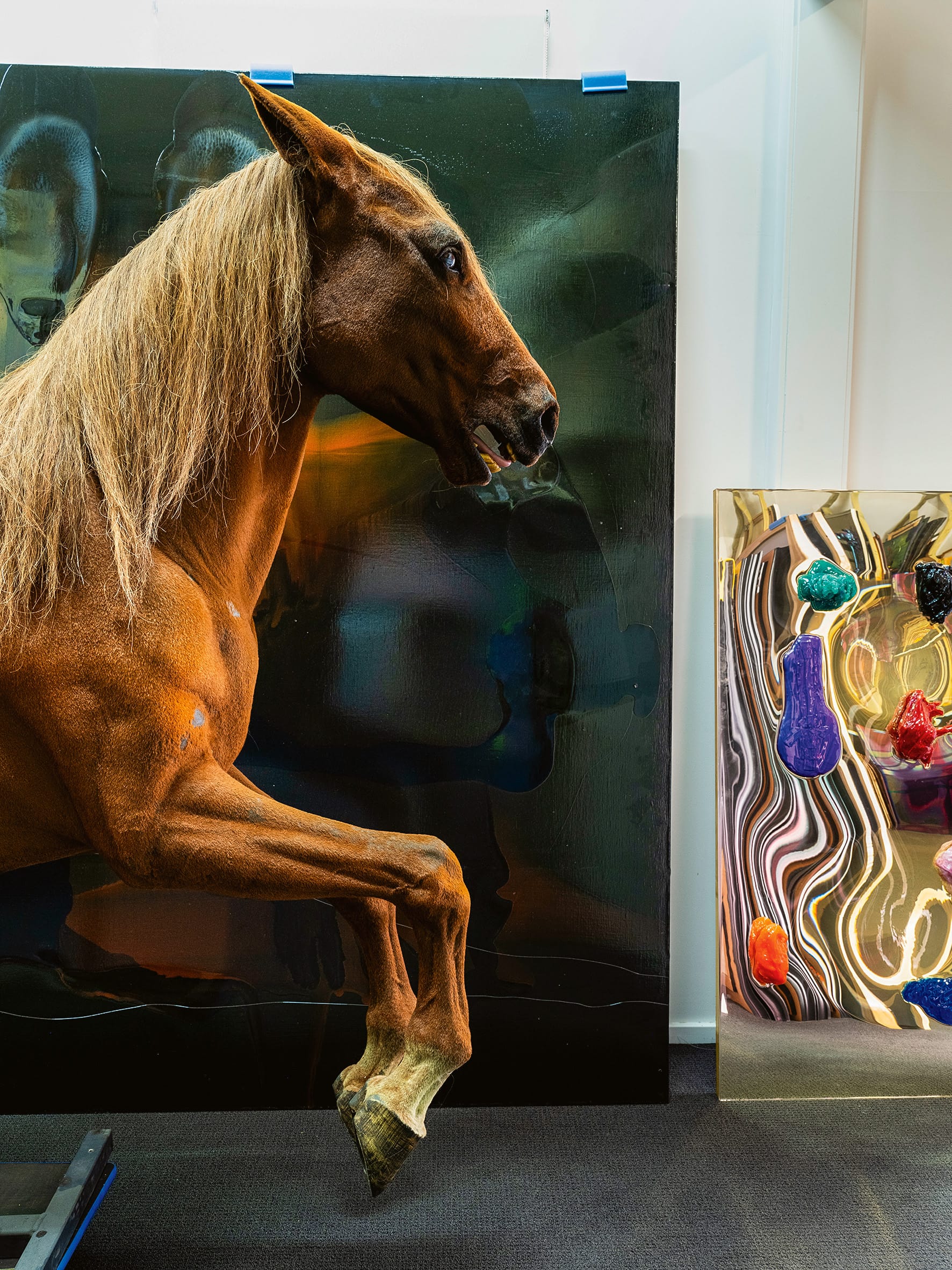
A 9m-tall cactus, Cereus peruvianus; sitting room with shell collection; foam sculptured horse, a prop from the movie Gladiator; bathroom with bubble-glass tiles produced for the Beijing Olympics. Photography Brigid Arnott.